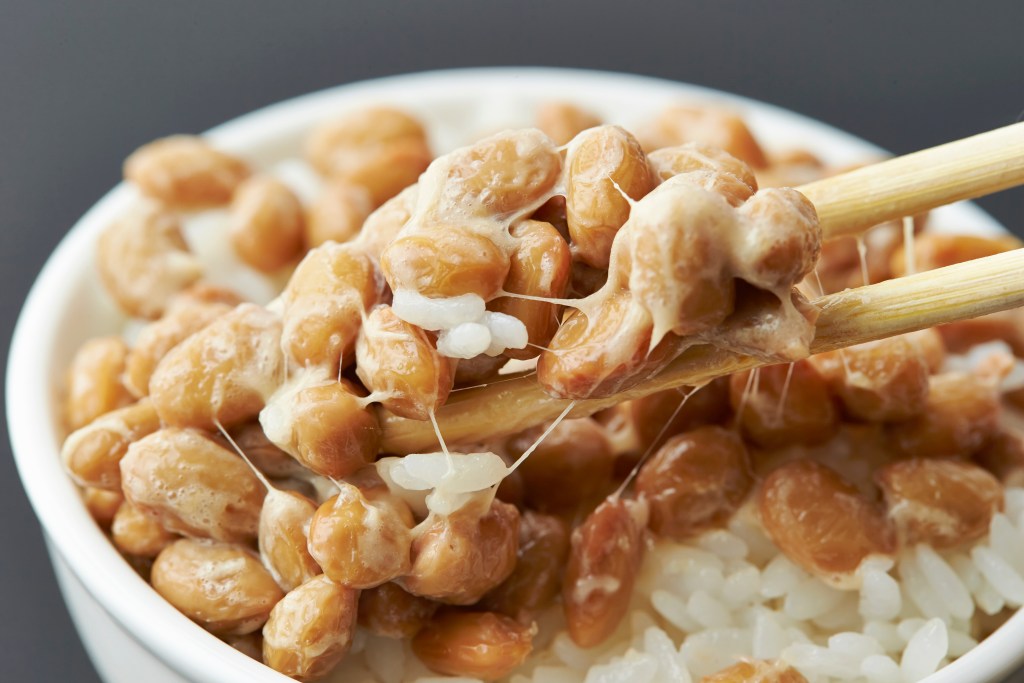
I discovered Natto beans when researching ways to prevent osteoporosis after my breast cancer diagnosis. The treatments I am taking mean I am at a higher risk of developing it. Food is medicine to me, so I decided to look up foods that can help strengthen my bones (and teeth). Natto beans are not only an excellent source of plant protein and a probiotic but also a bone fortifier.
Please note, in my humble opinion, like most probiotic foods, Natto beans are definitely an “acquired taste”. If you look at pictures you will see what I’m talking about. The sticky texture of the beans look almost alien like. Combine this with actual strings that protrude onto your spoon when eating. It looks not only weird, but is also called “stinky bean” for the pungent aroma as well.
Natto is Definitely an Acquired Taste for Americans
I eat Natto a few times a week. But I only eat it for the nutrition benefits. It’s not tasty at all but is edible.
However, bear in mind that I’m a fourth generation Japanese American. And I was raised very much on the Standard American diet. In fact, my parents had never heard of Natto before I showed it to them. And upon seeing it they refuse to try it.
However, my friend from Japan says that she loves the taste of Natto. Also, she actually craves it. But Japanese food is hard to find as she now lives in Ohio. And she has confirmed that many Japanese people love the taste of Natto.
And oddly, my toddler also seems to enjoy the taste as well. Hopefully, she has acquired a taste for it because it is in fact super healthy and nutritious.
In Japan, Natto beans along with rice are breakfast staple.

It’s rumored that around the 15th century, a samurai accidentally made natto beans by storing his soy beans in a straw container for several days. The soy beans fermented on their own. And that’s how Natto was (supposedly) created.
Natto is Super Healthy and Nutritious
Natto beans are very nutritious regardless of the origin.

Here is a nutrition breakdown in a single serving:
- Calories 211
- Protein 19.4 g
- Fat 11 g
- Carbohydrates 12.7 g
- Fiber 5.4 g
- Sugars 4.89 g
- Calcium 217 milligrams (mg)
- Iron 8.6 mg
- Potassium 729 mg
- Sodium 7 mg
Besides the calcium content, a key reason researchers believe that Natto is good for combatting Osteoporosis is the vitamin K2 in it. K2 is a vitamin that can help strengthen bones and teeth as well as help blood pressure and heart health.
How to Eat Store Bought Natto Beans
There is a way to make Natto at home yourself with a Natto starter kit. I will definitely not attempt to make it myself given my failed attempt to make my own kombucha.
I buy my Natto in little styrofoam packages at my local Japanese market. Fortunately, it’s not that hard to find ethnic foods in the LA metro area.

Each serving comes with its own little sauce packet and a little packet of mustard.
Simply mix it all up by stirring and enjoy! Or try to enjoy. Just eat it. It’s really healthy for you especially if you are trying to avoid bone fractures and the like.
Please note: Natto is commonly eaten on top of a bowl of steamed rice in Japan. Sometimes they add chopped green onions.
As always…Remember 2 Savor!
